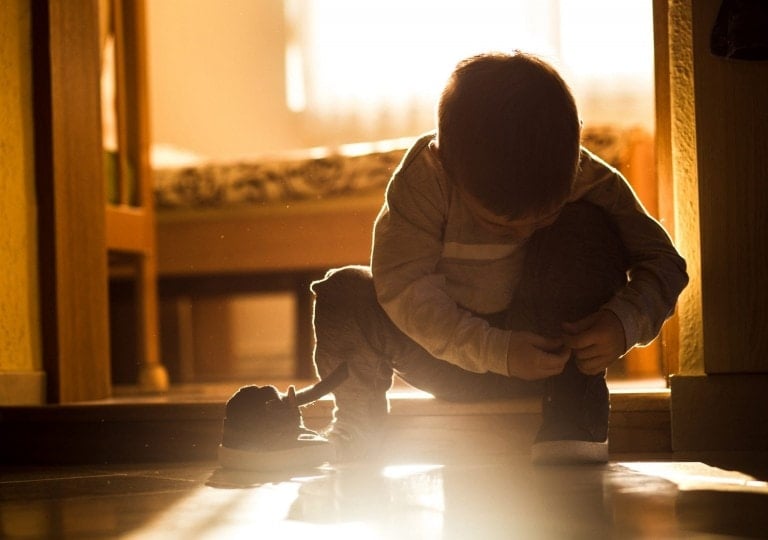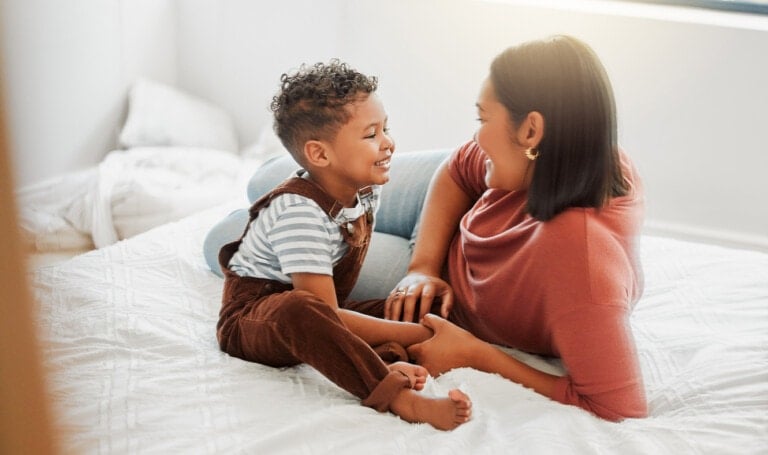Taking my three kids to quiet places like conferences, church, or the library has been incredibly overwhelming for me at times. It never failed that one of them would start running around the room like a crazy person and the other one would follow suit . . . since apparently, that was the cool thing to do at the moment. There were many times I lost my patience and went home feeling completely defeated. I eventually just started trying to avoid those kinds of settings altogether, knowing that it would not be fun for the other people there or us. But, over time, I’ve tried a few things that have worked! You guys, I can now venture out with my kids to quiet places and trust that they will stay (relatively) quiet. It’s glorious! Here’s what’s worked for us:
1. Practice at Home
At our house, we call it “blanket time.” Each of my kids gets a blanket and lays it out on the living room floor and gets one quiet activity to play with – my daughter usually gets her paper and crayons and my son loves to get his blocks. I set the timer and tell them they have to stay on their blankets until the timer beeps. If they need something, they can ask me for it but can’t get off the blanket. Then “blanket time” begins.
The first time we did this, my son got off the blanket about 20 times . . . in a 10 minute time block. I just kept reminding him, “you have to stay on the blanket,” and putting him back on it. Eventually, he’s learned to stay there. As your kiddos learn to stay on their blankets, you can begin to increase the amount of time and increase the expectation during that time. For example, you may start with one expectation – “stay on the blanket,” but as time goes on, you can add new boundaries like “only talk in a whisper” during blanket time to practice staying quiet and contained.
It has made a world of difference for us, and it’s also provided some excellent time for my kids to focus and settle a bit while we’re at home. Once they get it down at home, you can implement the same principles in public places.
2. Be Clear About the Expectations and Boundaries
This one is huge for us! It starts while in the car on the drive to the quiet place. I communicate with my kids where we’re going, what my expectations are for them, and what the consequences will be if those expectations are not followed.
Once we get there, I set clear boundaries for them. There have been times I’ve actually brought blankets with us for them to play on. There are other times I use something that’s already in the room we visit – one quiet place I take them regularly has beautiful area rugs around the room. We always choose a rug for the evening and camp out there. They know that they have to stay on the rug for the whole time we’re there, and I can stay in one spot, knowing I won’t have to chase them around the room while others are trying to sit quietly.
3. Bring Quiet Activities To Play With
A fun way to do this is to pack a “quiet bag” with special toys that your kids can only use when you go to quiet places. This is a great way to keep them entertained since they will have toys to use that they don’t already use daily. It’s also a great way to make staying quiet, fun, and exciting for them.
4. Know the Limits and Have Appropriate Expectations
Although it has become much easier for me to take my kiddos to quiet places, it is still not perfect. I always have to consider the time of day and length of time we’ll all need to stay quiet before taking my kids there. My 3-year-old can last about 30 minutes at this point. Anything past that puts him over the edge. And if I try to push him past his bedtime, forget it. I will, for sure, be chasing a loopy, overtired boy around the room, no matter how good he’s gotten at “blanket time” at home.
It’s also important to set your expectations appropriately and to know that everyone else in the room does not expect your kids to be silent. My kids are notorious for trying to whisper something to me, but saying it at full volume . . . the only thing about it that resembles a whisper is that their mouth is right next to my ear. Just remember – they’re kids, and there will be times that they’re not perfectly quiet. And that’s ok! People will completely understand, and even if they don’t, it’s not for you to worry about. As long as you don’t feel overwhelmed, your kids have fun and can stay relatively quiet and contained, count it as a win!
Here’s to happy venturing out of your house to quiet spaces, mama. You can do it!!































